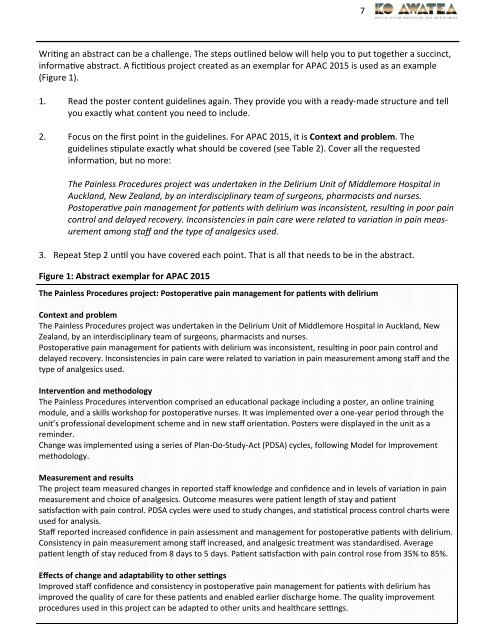Tips-and-Tricks-for-Poster-Displays-APAC-2015
Tips-and-Tricks-for-Poster-Displays-APAC-2015
Tips-and-Tricks-for-Poster-Displays-APAC-2015
Create successful ePaper yourself
Turn your PDF publications into a flip-book with our unique Google optimized e-Paper software.
7Wri&ng an abstract can be a challenge. The steps outlined below will help you to put together a succinct,in<strong>for</strong>ma&ve abstract. A fic&&ous project created as an exemplar <strong>for</strong> <strong>APAC</strong> <strong>2015</strong> is used as an example(Figure 1).1. Read the poster content guidelines again. They provide you with a ready-made structure <strong>and</strong> tellyou exactly what content you need to include.2. Focus on the first point in the guidelines. For <strong>APAC</strong> <strong>2015</strong>, it is Context <strong>and</strong> problem. Theguidelines s&pulate exactly what should be covered (see Table 2). Cover all the requestedin<strong>for</strong>ma&on, but no more:The Painless Procedures project was undertaken in the Delirium Unit of Middlemore Hospital inAuckl<strong>and</strong>, New Zeal<strong>and</strong>, by an interdisciplinary team of surgeons, pharmacists <strong>and</strong> nurses.Postopera&ve pain management <strong>for</strong> pa&ents with delirium was inconsistent, resul&ng in poor paincontrol <strong>and</strong> delayed recovery. Inconsistencies in pain care were related to varia&on in pain measurementamong staff <strong>and</strong> the type of analgesics used.3. Repeat Step 2 un&l you have covered each point. That is all that needs to be in the abstract.Figure 1: Abstract exemplar <strong>for</strong> <strong>APAC</strong> <strong>2015</strong>The Painless Procedures project: Postoperave pain management <strong>for</strong> paents with deliriumContext <strong>and</strong> problemThe Painless Procedures project was undertaken in the Delirium Unit of Middlemore Hospital in Auckl<strong>and</strong>, NewZeal<strong>and</strong>, by an interdisciplinary team of surgeons, pharmacists <strong>and</strong> nurses.Postopera&ve pain management <strong>for</strong> pa&ents with delirium was inconsistent, resul&ng in poor pain control <strong>and</strong>delayed recovery. Inconsistencies in pain care were related to varia&on in pain measurement among staff <strong>and</strong> thetype of analgesics used.Intervenon <strong>and</strong> methodologyThe Painless Procedures interven&on comprised an educa&onal package including a poster, an online trainingmodule, <strong>and</strong> a skills workshop <strong>for</strong> postopera&ve nurses. It was implemented over a one-year period through theunit’s professional development scheme <strong>and</strong> in new staff orienta&on. <strong>Poster</strong>s were displayed in the unit as areminder.Change was implemented using a series of Plan-Do-Study-Act (PDSA) cycles, following Model <strong>for</strong> Improvementmethodology.Measurement <strong>and</strong> resultsThe project team measured changes in reported staff knowledge <strong>and</strong> confidence <strong>and</strong> in levels of varia&on in painmeasurement <strong>and</strong> choice of analgesics. Outcome measures were pa&ent length of stay <strong>and</strong> pa&entsa&sfac&on with pain control. PDSA cycles were used to study changes, <strong>and</strong> sta&s&cal process control charts wereused <strong>for</strong> analysis.Staff reported increased confidence in pain assessment <strong>and</strong> management <strong>for</strong> postopera&ve pa&ents with delirium.Consistency in pain measurement among staff increased, <strong>and</strong> analgesic treatment was st<strong>and</strong>ardised. Averagepa&ent length of stay reduced from 8 days to 5 days. Pa&ent sa&sfac&on with pain control rose from 35% to 85%.Effects of change <strong>and</strong> adaptability to other se1ngsImproved staff confidence <strong>and</strong> consistency in postopera&ve pain management <strong>for</strong> pa&ents with delirium hasimproved the quality of care <strong>for</strong> these pa&ents <strong>and</strong> enabled earlier discharge home. The quality improvementprocedures used in this project can be adapted to other units <strong>and</strong> healthcare se?ngs.


